Most of GM has stopped making cars – soon to include Chevrolet, which plans to stop making the Camaro after the end of this year and has already announced the cancellation of the Malibu, which leaves Chevy (and Buick) with nothing other than crossovers and trucks and SUVs.
But there’s still Cadillac – and the CT4.
It’s more than just a car, too. It’s the kind of car that people who like cars like – because it’s not just another FWD/AWD penalty box with a cramped back seat and not enough space in the trunk, although it has both of the latter. 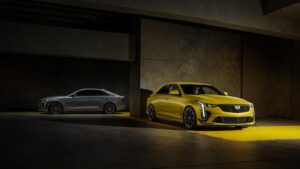
What It Is
The CT4 is a compact-sized, luxury-sport sedan that comes standard with a few things that are getting very hard to find in a sedan at this price point – such as standard rear-wheel-drive. As well as some things that are getting almost-impossible-to-find in a sedan, period – such as the six speed manual transmission that’s standard in the highest-performance (Blackwing) trim.
Prices start at $34,595 for the base Luxury trim, which comes standard with rear-wheel-drive, a turbocharged 2.0 liter engine and an eight speed automatic. All-wheel-drive is available as a stand-alone $2,000 option.
For a little more engine – and a lot more power – there’s the V-Series, which gets a larger 2.7 liter four cylinder engine (also turbocharged) along with a bevy of performance upgrades that include a limited slip rear differential, free-flow exhaust system, an adaptive suspension, Brembo brakes, sport seats, aluminum pedals, rear spoiler and a 14 speaker Bose premium audio system.
This version of the CT4 lists for $47,095.
You can also get a slightly less potent version of the 2.7 liter engine in the $39,495 Premium Luxury trim.
You can get two more cylinders – and a lot more power – in the top-of-the-line Blackwing trim, which centers around the 472 horsepower 3.6 liter twin-turbo V6 and the standard six speed manual transmission that make this Caddy one that really zigs.
It lists for $61,495.
If you want, you can opt for a ten speed automatic as a stand-alone option for $2,275.
But why would you?
The CT4 carries over unchanged for what may be its final year of availability.
What’s Good
Entry price point is thousands below that of two of the other major contenders in the segment, the $46,950-to-start Mercedes C300 and the $44,500-to-start BMW 3 Series sedan.
It is the only sport sedan in the segment you can buy for less than $76,000 – the price of a ’24 BMW M3 sedan – that’s still available with a manual transmission.
Three available engines to choose from.
What’s Not So Good
Very small trunk (just 10.7 cubic feet).
Very tight back seat (just 33.4 inches of legroom).
Manual transmission only available in the top-of-the-line Blackwing.
The CT4’s standard engine is the type (and size) engine that’s becoming ubiquitous in almost everything: A 2.0 liter turbocharged four cylinder engine. Both of the CT4’s main rivals – the BMW 3 Series sedan and the Mercedes C300 sedan – also come standard with turbocharged 2.0 liter four cylinder engines.
But there are some differences.
The first is the Caddy’s 2.0 liter isn’t paired up with a “mild hybrid” system that cycles the engine off as often as feasible, in order to achieve an incremental increase in fuel efficiency and an incremental decrease in the “emissions” of the dread gas, CO2 – which isn’t a pollutant but is believed by some to be causing the “climate” to “change.”
The Benz C300 has such a system, which may account for why it costs $12,355 more to start than the Cadillac. The BMW 3 sedan does not come standard with a mild-hybrid set-up, so it’s hard to understand why it costs $9,905 more than the Cadillac.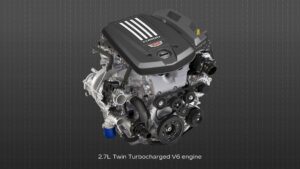
Neither of the two come standard with appreciably more horsepower, either. The BMW and Benz’s 2.0 fours both claim to make 255 horsepower vs. 237 for the Caddy’s 2.0 liter four – which is paired with an eight speed automatic.
If you’d like appreciably more power for about what BMW and Benz ask for not-that-much-power, you can opt for the 2.7 liter turbo four that power the V-Series version of the CT4. It summons 325 horsepower (and 380 ft.-lbs. of torque) and you can get it for $145 more than Benz is asking for a base trim C300 with 255 horsepower and just 2.0 liters.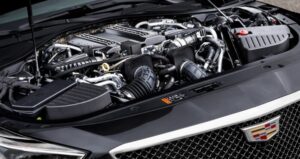
It’s a little better (or worse, depending on how you look at – and your brand loyalty) vs. the BMW 3 Sedan. It’s $2,595 less to start than the V-Series Caddy with the 2.7 engine but – again – all you don’t get is 2.0 liters and just 255 horses.
You can get six cylinders (and 3.0 liters) as well as 382 horses in the M340i version of the 3 Series sedan. But that upgrade will cost you $57,600 – and that puts its cost within the same price range as the Blackhawk iteration of the CT4, which also comes with six cylinder (and 3.6 liters) and 472 horsepower – for only $3,895 more than BMW asks for 90 fewer horses – and forget the manual transmission.
BMW fires back with the M3 – which has a 473 horsepower version of the 3.0 liter six and also comes standard with a manual transmission. But it also costs $76,000 to start – $14,505 more than the Caddy Blackwing.
To get one more horsepower.
All of the CT4’s engines can be paired with rear-drive or (optionally) all-wheel-drive, except for the Blackwing.
Because why would you want to?
If you remember the period – this was back in the ’90s – when Cadillac was trying to change its image (as well as its demographic) from purveyor of heavy-rollers that tended to do just that in the curves – assuming the geezer behind the wheel got it going fast enough – to a brand like BMW that sold luxury-sport sedans that liked being driven fast in the curves – you’ll remember Cadillacs that didn’t exactly zig, like the 1997-2001 Catera.
But at least it didn’t roll – and spit hubcaps – in the curves.
This Caddy rocks.
To drive it is to appreciate it. Especially in the curves. You hardly have to slow down for them. You can get on the gas in them – and that is something that wasn’t especially helpful (or wise) to do in the Cadillacs of the past, unless you liked to roll.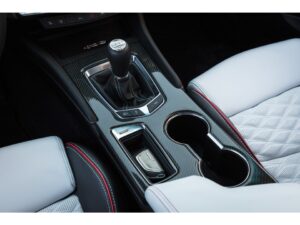
But what puts many furlongs of distance between the CT4 and anything else you can buy for anything close to what Cadillac asks is the manual transmission that is standard in the Blackwing – and the AWD that isn’t available.
The electronically controlled, almost infinitely programmable modern automatic can outperform a manual in terms of shifting faster and at exactly the right moment for optimum 0-60 and lap times. But numbers cannot convey feelings. A manual summons them. You can literally feel the transmission (and via it, the engine) through the shifter, which is an almost-living thing compared with the completely disconnected drive-by-wire selector all modern automatic-equipped cars have that you move – or tap – without feeling anything, from Park to Drive.
And then there is the other connection to the engine, via the clutch pedal and the feedback you get through your left leg. No matter how much “better” – by the numbers – an automatic may be, what makes driving a car fun is being closely connected to the experience of driving and that is something that’s lost in transmission with an automatic.
The V6 is also part of what makes this car one of the all-time greats. It is the same basic V6 that GM has used for years in many of its vehicles, including the soon-to-be-cancelled Camaro, as its “base” engine. Here it makes more power than the Camaro’s optional 6.2 liter V8, which musters a comparatively feeble 455 horsepower.
The CT4 Blackwing is quicker, too – 0-60 in 3.9 seconds vs. 5.4 seconds for the Camaro, which is also about 200 pounds heavier. And it is far more stealthy. People who do not know what it is do not know what it can do whereas everyone knows what a Camaro is – as well as the probable intentions of those who own one.
The Caddy’s back seats are tight – but usable. The Camaro’s aren’t. In part because there are only two doors, of course – but also because there is almost literally no legroom and very little headroom. More on this follows below but suffice to say here that you can use the CT4 to carry more than just one passenger. The Camaro has become an almost-Corvette in this respect; one that – ironically – has even less cargo-carrying capacity (just 9.1 cubic feet) than the two-seater Corvette (which has 12.6 cubic feet).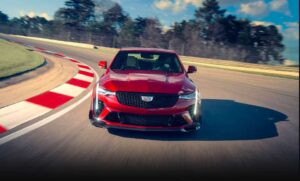
You can also see out of the CT4 – and that’s not nearly as easy to do from inside the Camaro.
So what we have here is a more practical Camaro as well as a more adult one.
It’s just a shame that Cadillac restricts the fun of the manual to the most-expensive Blackwing version of the CT4. To be fair, it’s not Cadillac, per se, that’s at fault. It’s the government regs pertaining to “fleet average fuel economy” that have made it difficult to mass-produce manual transmission’d anything – because of the 2-3 MPG less a given car will rate on government fuel efficiency tests with a manual vs. an automatic that can be programmed to the test.
You can’t program a manual.
And the problem then becomes the downward drag on a manufacturer’s “corporate average” fuel economy numbers resulting from too many sales of manual-equipped cars. So the perverse incentive becomes to reduce sales of manual-equipped cars, by making them expensive cars.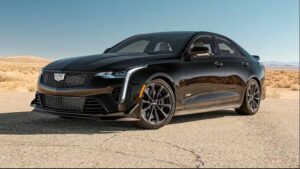
And that’s why you can’t get a manual with the 2.0 or the 2.7 engines, even though everything else would bolt right into place – and probably put a smile on a lot of potential buyers’ faces.
It’s the same, by the way as regards the BMW 3 – which is only available with a manual in the iteration of it (the M3) almost no one can afford.
At The Curb
The CT4 is a small sedan – just 185.9 inches long.
That means it’s got about the same footprint as a Toyota Corolla (which is 182.5 inches long). But because it’s rear-wheel-drive (and has its engine mounted front to back rather than sideways) its proportions – and allocation of space – are very different.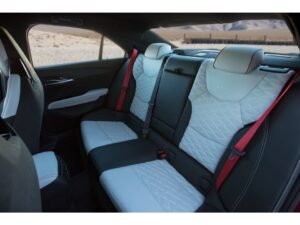
The hood is longer – which looks good – but it comes at the cost of rearseat legroom, of which there’s only 33.4 inches, which is much more than in the backseat of a Camaro (29.9 inches) but not as much as in the backseat of a small sedan designed to be practical, like the Corolla (which has 34.8 inches). There’s also less room in the abbreviated trunk – which is the price of looking good. Ditto the headroom, particularly in the rear, due to the low (and getting lower as it tapers backward) roofline. It drops from 38.3 inches up front to 36.5 inches in back.
The Caddy’s main rivals – the Benz C300 and the BMW 3 Sedan – have some of the same deficits, but to a lesser extent.
The BMW has 35.2 inches of backseat legroom and 37.6 inches of rearseat headroom. It also has a big-car’s 16.9 cubic foot trunk, even though its overall length (185.9 inches) is a couple of inches less than the Caddy’s. The Benz has 36 inches of rearseat legroom and 37.5 inches of headroom in the rear – plus a split-the-difference 12.9 cubic foot trunk. 
However, you pay for that – literally – in the way of paying much more to get into either car.
The Caddy’s low entry-price point not just relative to its rivals but as such is arguably its strongest selling point. That and the fact that you can get more engine – and more horsepower – for about the same money, too.
The standard 8 inch LCD touchscreen that Pop Tarts out of the center stack is a little cheap looking because cheap cars (like Corollas) come with very similar-looking LCD touchscreens Pop Tarting out of the center stacks. But the rest of the car – inside and out – is both attractive and distinctive, Cadillac stylists went for angles rather than curves and so the CT4 looks different than its lozenge-themed competitors.
Blackwing trims get a unique-to-this trim digital display main gauge cluster, as well as the option to get lumbar-massaging seats and a 14 speaker AKG stereo system. Unfortinately, it also comes standard with the same cheesy-looking 8 inch secondary touchscreen Pop Tarting out of the center stack.
The Bottom Line
GM hasn’t made it official yet, but the rumor is that the CT4 (and its mid-sized brother, the CT5) are not long for this world. If true, 2024 might be your last chance to buy a Cadillac that actually does zig.
. . .
If you like what you’ve found here please consider supporting EPautos.
We depend on you to keep the wheels turning!
Our donate button is here.
If you prefer not to use PayPal, our mailing address is:
EPautos
721 Hummingbird Lane SE
Copper Hill, VA 24079
PS: Get an EPautos magnet or sticker or coaster in return for a $20 or more one-time donation or a $10 or more monthly recurring donation. (Please be sure to tell us you want a magnet or sticker or coaster – and also, provide an address, so we know where to mail the thing!)
If you like items like the Baaaaaa! baseball cap pictured below, you can find that and more at the EPautos store!



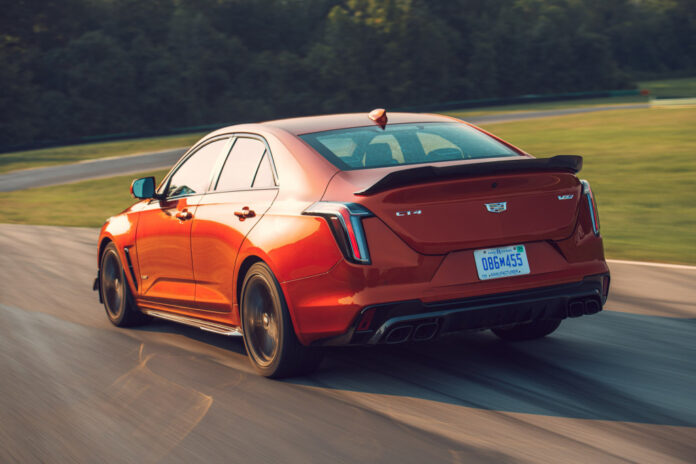

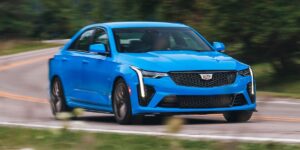
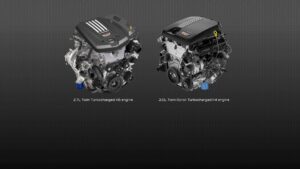









Since the backseat isn’t big, why not a coupe?
Two doors are getting as rare as manuals.
Buy a fast Cadillac….. then they won’t let you drive it fast….no more fun…
Orwell Hits The Highway: Starting This Month Cars In Britain Will Have “Speed Limiters”
https://www.zerohedge.com/markets/orwell-hits-highway-starting-month-cars-britain-will-have-speed-limiters
That Cadillac is better then a Geeley EV….
How bad are Chinese EV’s?….
The….Geeley…. Volvo EX30 Electric Car has been REMOVED from sale!
Huge software issues….
Screens going black…steering wheel buttons not responding, emergency braking system randomly activating….. won’t charge…piece of junk….
Customers are returning them and getting refunds….
https://www.youtube.com/watch?v=yCfuZYBMRGk
” the six speed manual transmission that’s standard in the highest-performance (Blackwing) trim.”
A proper driver’s car has to have a stick shift…..
It is getting harder for the poor people to get a sports car with a stick shift….soon it will only be available to the rich ruling class…
The £2.8m GMA T.50 is only available with a manual gearbox, the £2.2m Pagani Utopia can be had with two or three pedals (with most owners opting for the latter) and at the other end of the scale…
In-between (though still very much at the expensive end of the scale) we have these two: the £1m Aston Martin Valour and the £231k Porsche 911 S/T.
An Aston with a stick shift….
The Valour pairs a manual gearbox with Aston’s twin-turbo 5.2-litre V12 for the first time, and those mechanicals are clothed in retro-inspired carbonfibre bodywork. Just 110 will be made, at £1m-plus each.
As for the Porsche, you can look at it either as a 911 GT3 RS with a manual gearbox and without that wing, or as a GT3 Touring with the wick turned up. Either way, it marries an epic engine that revs to 9,000rpm, with a manual ‘box and lightweight clutch…..a performance bargain….supercar performance for far less money…..
https://www.youtube.com/watch?v=cEO6mVqo8K8&pp=ygUMYXN0b24gbWFydGlu
Aston Martin Valour…….Just 110 will be made, at £1m-plus each…..buy one…flip it later for a profit?….
This review made me think of something I’ve been tossing around.
Instead of a standard road test for driver’s license, why isn’t it conducted at a road track or a racing school?
You would learn how to drive into curves, stop, slide, drift, accelerate, and recover an out of control car.
Sure the government would say that defeats the purpose of defensive driving, but I say it would make better drivers who would be able to stay out of accidents.
It would also increase the demand for people to be able to have fun cars instead of the boring facsimiles that are being churned out currently.
I think it would be a great idea, but it will never happen. Most places barely test anymore.
Of course, there are private options. When my son first got his license, I enrolled him at a class at a track. Not for racing, but for the things you mentioned. It made him a MUCH more competent and confident driver.
https://www.birmn.com/streetsmarts
‘If you want, you can opt for a ten speed automatic as a stand-alone option for $2,275.’ — eric
Whuuuut? That’s insane.
In any vehicle other than hypercars which hit 200+ mph, more than six gears is superfluous. They exist for only one reason: to game the fedgov’s dystopian CAFE dynamometer.
Gears-out-the-wazoo earn the manufacturer regulatory compliance and penalty avoidance. They do diddly-squat for actual drivers, other than break down thanks to their mind-numbing complexity.
Cadillac ought to offer customers a $2,275 credit for bearing the grievous burden of the GHG-10 (Greenhouse Gas 10-speed) transmission, so that other drivers may breathe the fresh air of freedom.
I love my Caddy ninety nine degree
But that mama got a pistol an’ laid it down on me
Stop breakin’ down
Baby please stop breakin’ down
— Rolling Stones, Stop Breaking Down
What a cool little car! ChrisIN’s wife has the Blackwing, I believe.
It’s kind of sad how the fun sedans are all but extinct. For my age group, the M series was always the aspirational choice. But really all the European companies made fun and fast sedans. Even boring Volvo!
Thanks for the review, Eric!
Thanks for the kind words, Yeti!
I’m happy top praise even GM – when deserving – and this is one of those times!
Yes she does Yeti. Great write up Eric. You nailed it as always.
All I can add as an owner of the Blacking version, we’ll I don’t, she does. I add this fact because I really really want to AutoX race this car and she won’t let me…………
All I can add is the small back seat and small trunk doesn’t matter a hill of beans, because it’s so much fun to drive nothing else matters. You can throw your large piece of extra luggage (hers) for the airport in the back seat.
ohhh, one thing you missed was the special ‘V’ button. It makes the car. Why?
Because GM’s adaptive suspension is spectacular in this car. Turn V off and she’s a pretty nice riding/sounding very fast luxury, race-car sedan. Want to have a little fun? Hit the V button, and she turns into a snarling dragon with spits and crackles, and it stiffens it to race car track mode (adjustable as well). We giggle like we’re teenagers.
A little sad note is I talked her into the auto trans, don’t shoot me. She hates the cold, and we don’t have a garage, so the auto is the only way she could remote start it in the winter. But she recently said “hell with remote start, I’m getting the manual next time” haha…..
Caddy………..please keep this car going…………….. it’s sets your tone in a very good way.
Want an even better step-up. Look up the CT5 V Blackwing…………holly hell. Even though she keeps saying she’s getting that one next. I know she won’t though cause her heart can’t justify the mega $ more for it.
If you enjoy fast sports cars, you owe it to yourself to go test drive one, you won’t be disappointed. I heard they only make around 1500 4 Blackwings and 1500 5 Blackwings a year, so not easy to find. Our dealer had 3 in the East, but I searched for one in our Western home area and none to be found in 300 mile radius.
Pretty sure they make them all at once, one time a year, and I don’t know when that is.
These would sell about 10x more if they had the 490hp LT1
They can’t afford to sell 10X more! CAFE would chew them up!
correct Yeti, and probably why they only make a very small amount of each model 4 and 5 Blackwings.
But for Snakecharmer, how about 668HP in the CT5 V Blackwing with the 6.2 supercharged unit????? But it’s $100K.
I have a question and a comment. First is my question: how come cars in Europe, which has tighter regs, are commonly available with manual transmissions? If what you say about gov’t regs eliminating manuals is true, shouldn’t the European cars have nothing but automatic trannies?
Now, for my comment: this car’s trunk is almost as small as a Miata’s! Even though it’s a bigger, heavier sedan, its trunk isn’t much bigger than the trunk on a Mazda Miata.
Hi Mark,
It’s because the regs are different; in Europe, they add exorbitant taxes to fuel. Here, the government levies CAFE fines upon automakers, who bake them into the cost of vehicles.
And yet the Euroweenies can still get Diesel cars, right? At least till 2035 when they ban all fossil fuels. All the while shuttering coal and nuclear energy production.
But manuals can be short shifted to boost fuel economy. Wouldn’t that help meet the CAFE standards?
Hi Mark,
It depends who’s doing the shifting… and therein lies the problem!
Why can’t the car companies simply instruct their test drivers to shift at X RPM to boost fuel economy? That’s no different than programming the car’s computer to do the same; after all, programs are nothing but computer instructions.
Also, it depends on who’s driving a car with an automatic transmission; if they mash the gas, it’ll drop to a lower gear and boost revs; that, in turn, boosts fuel burn.
Hi Mark,
The tests are done by the government is why.
Oh? I thought that the car companies did the tests, then turned in the results to the gov’t. Wasn’t Hyundai implicated in falsifying its mileage numbers or something? How could it do that unless it did the tests themselves?
Having the gov’t test the cars invalidates the tests, IMO. Depending who tests the car and how, the results could be totally different, especially with a manual transmission. By short shifting and being gentle on the gas, you can get awesome numbers.
The push to do fuel economy tests of trucks is BS too, because they can be configured with various transmissions, engines, etc.; there’s no uniform basis for comparison, so fuel economy numbers for trucks are BS.